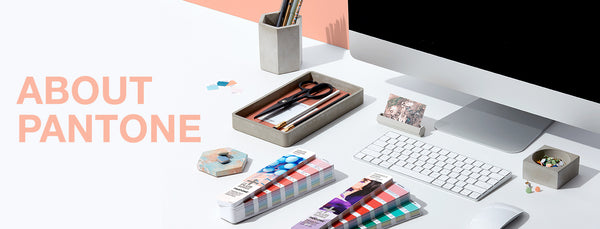Pantone Colour Swatches, Charts & Guides
 Welcome to the SHOP21 Pantone colour swatches, charts and guides brand page! Here you will find an introduction to the brand as well as further information about their products and systems, as well as a great collection of resources to help support both your use and understanding of their products and technologies.
Welcome to the SHOP21 Pantone colour swatches, charts and guides brand page! Here you will find an introduction to the brand as well as further information about their products and systems, as well as a great collection of resources to help support both your use and understanding of their products and technologies.
What is Pantone, a definition:
The clue is in the name, 'Pan' is the ancient Greek word meaning ‘All’ and ‘Tone’ means the lightness and/or darkness of any basic colour. So the name literally means ‘All Tones’, or in other words ‘All shades of a colour's lightness (tints) and darkness (shades)’. It’s a system of standardisation to help communicate colour accurately across as many applications as possible. Pantone equals colour control! They make a range of products in different formats that accurately communicate colours via their own proprietary colour system. Their two main systems are the Graphics System and the Fashion, Home and Interiors System, and come in the below formats.
Pantone Colour Charts Formats:
Pantone colour chart products are colour guides that come in the following formats:
- Paper Fan Deck Guide Books
- Textile Fabric Swatches and Books
- Paper, Plastic and Cotton Chips
The Fan Guides and Chip Books are a guide to the colour:
These are produced with the same ink recipe each time but if there are other variables in production such as water quality, temperature and humidity this could lead to a slight change in the colour produced. These would not be picked up as quality control of these products is more about print registration and if the pages are cut or perforated properly, rather than an exact measurement of the colour.
The Fabric Swatches are an actual engineered standard:
They are dyed to match the original colour specification each time they are produced. They have to meet strict quality criteria including a colour measurement of less than DE 0.5 as well as being on the same side of the standard in terms of hue, chroma and lightness as the previous batches which can lead to production delays. The Plastic Standard Chips are also an actual engineered standard.
Pantone colour products are most frequently used for branding, printing, signage and packaging as well as fashion and product design. We have divided all these products into their own collections listed below, or use the drop-down menu in our main navigation above by clicking 'PANTONE':
- Chips (Paper)
- Chips (Plastic)
- Colour Bridges
- Digital Devices
- Fashion Homes and Interiors
- Libraries and Collections
- Metallics
- Pastels and Neons
- Plastics
- Process and CMYK
- Solids
Story and History
 This innovative and groundbreaking company has set the international standard for accurate colour management solutions since the 1960’s when the founder Lawrence Herbert, set out to harmonise the creative vision of colour professionals with the actual end result, helping them to more accurately achieve their design objectives. Lawrence was hired by the Apparel and Cosmetics advertising industry specialists, and old school classic ‘Mad Men’, Mervin and Jesse Levine, based in New York (now a subsidiary of the Grey Advertising Agency) soon after leaving University. The Levine brothers had their own stock of pigments and produced their own coloured inks but Lawrence was confident he could utilise his knowledge of chemistry to improve both the quality and categorisation of the companies colour technology assets and develop a much better matching system of colour standardisation.
This innovative and groundbreaking company has set the international standard for accurate colour management solutions since the 1960’s when the founder Lawrence Herbert, set out to harmonise the creative vision of colour professionals with the actual end result, helping them to more accurately achieve their design objectives. Lawrence was hired by the Apparel and Cosmetics advertising industry specialists, and old school classic ‘Mad Men’, Mervin and Jesse Levine, based in New York (now a subsidiary of the Grey Advertising Agency) soon after leaving University. The Levine brothers had their own stock of pigments and produced their own coloured inks but Lawrence was confident he could utilise his knowledge of chemistry to improve both the quality and categorisation of the companies colour technology assets and develop a much better matching system of colour standardisation.
The Pantone Matching System
Not only did he succeed with these improvements but he ended up creating the most accurate colour standardisation and reproduction process available at that time. Later on, in 1963 he actually ended up buying the colour technology side of Levine brothers advertising agency, that he had done so much to improve. He named the new business ‘Pantone’, and so the Pantone Matching System (PMS) was born. He continued to further develop this standard, and the products that communicate it, so PMS has remained the international standard ever since. This colour systems usefulness caused it to become ever more popular from the 1960s onwards and now is the standard, and hence used as the colour foundation for most design professionals workflows.
This technology has provided everyone professionally involved in colour to better communicate, and manage communications of the correct colours across all departments, and stakeholders, from designers to the manufacturers to the printers etc. Even doing this internationally across continents without these stakeholders having to actually meet each other. In the ‘old days’, you would literally have to physically take your final colour decisions regarding whatever you were designing and show them to the printer/manufacturer, so everybody was absolutely clear about what the actual final colour to be used for that creative project definitely is! With the Pantone system, this is all now communicated with a numerical code which can, of course, be sent all over the world from designers computer to printers printing systems for example.
PMS lies at the heart of all the Pantone colour control solutions, from their charts and guides to their swatches and now, of course, their digital solutions like their software product, the Colour Manager and their digital devices, such as the Capsure.
Pantone introductory video: "Making Colour Connect"
Digital Media
As digital m edia started to explode from the 1980s onwards, first via the desktop publishing revolution, then later via the adoption of the world wide web through the 1990s, the need for accurate colour control within digital workflows was paramount. Lawrence's son Richard Herbert, who was also the Chief Technology Officer, followed in his father’s innovative footsteps, setting up the Electronic Colour Division in 1984, (as well as the Textile Colour System) to help Pantone provide colour communication solutions in the digital age. RGB Since the primary vehicle for colour consumption in the digital era was a computer screen such technologies had to focus on the energies emitted in the Electromagnetic Radiation Spectrum (ERS), by these electronic screens, they are Red, Green and Blue, most frequently referred to as simply RGB. Pantone's Colour Manager Software enables you to import the RGB colours of the different palettes. Here’s a useful RGB to Pantone converter tool as well as a tool to convert RGB or Hex to pretty much anything.
edia started to explode from the 1980s onwards, first via the desktop publishing revolution, then later via the adoption of the world wide web through the 1990s, the need for accurate colour control within digital workflows was paramount. Lawrence's son Richard Herbert, who was also the Chief Technology Officer, followed in his father’s innovative footsteps, setting up the Electronic Colour Division in 1984, (as well as the Textile Colour System) to help Pantone provide colour communication solutions in the digital age. RGB Since the primary vehicle for colour consumption in the digital era was a computer screen such technologies had to focus on the energies emitted in the Electromagnetic Radiation Spectrum (ERS), by these electronic screens, they are Red, Green and Blue, most frequently referred to as simply RGB. Pantone's Colour Manager Software enables you to import the RGB colours of the different palettes. Here’s a useful RGB to Pantone converter tool as well as a tool to convert RGB or Hex to pretty much anything.
Hexachrome and CMYK
Richard also co-created new colour technologies such as Hexachrome, also known as the CMYKOG process, in 1995. Adding Orange and Green to the most popular printing process, the four colour process called CMYK which is based on, and stands for, the primary pigments: Cyan (Aqua), Magenta (Pink), Yellow & Key (Brown, Blue or Black) significantly improved colour reproduction via this extended gamut. This was discontinued in 2008 when Adobe stopped supporting the HexWare plugin for it, which had allowed digital designers to work with it in the context of RGB. Heres a good Hex to Pantone converter tool. There are also some CMYK converters you may find of assistance too, including:
Support & other related links for Pantone
- Help Center
- Product Registrations
- Colour Finder
- Dyestuff Formulations
- Colour Fastness & Managing Fluorescents
- Colour Institute
Corporate and European Union (EU) Purchasing
We are one of the UK & EU's first online stores and are well placed in this market sector and are hence able to offer good corporate terms. Please contact us to discuss volume purchasing of Pantone colour charts, guides, swatches and related products and to discuss trade credit accounts.
For European Union based business with a valid VAT registration number then you can purchase Pantone colour charts and guides from us at the ECG intra-community delivery VAT rate of zero per cent (0%).
